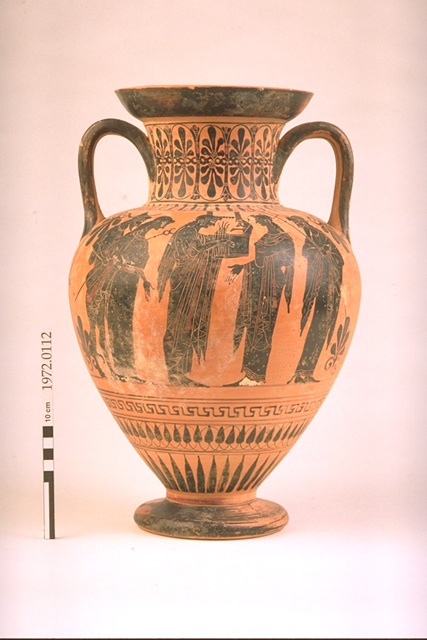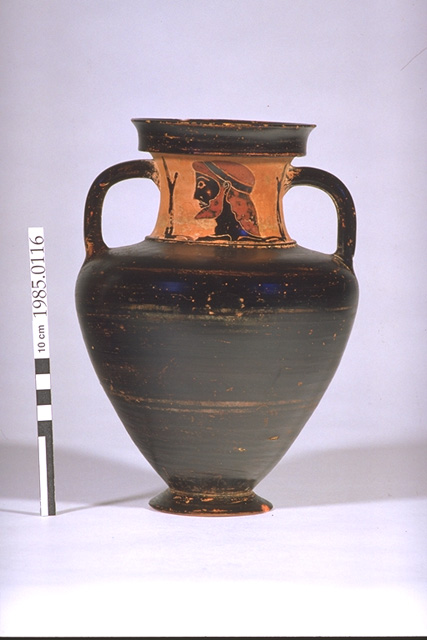Neck amphora
Download

Neck amphora, c. 530 BCE ceramic
25.9 × 16.9 cm (diameter)
Purchased 1982 to honour the work in the department of G.H. Gellie and Professor G.W. Clarke
Classics and Archaeology Collection
University of Melbourne Art Collection
1982.0178

Ian Potter Museum of Art, University of Melbourne
This Attic clay vase displays a particular technique in which black figures, incised with details, form a narrative scene contrasted against a red clay-coloured background. Scenes on such vases are often inspired by stories in literature such as the Iliad and Odyssey; warriors such as Herakles (Hercules) feature among the figures. Black-figure vases in the Ian Potter Museum of Art date from the sixth to the fifth centuries BCE, periods reflecting Athenian tastes, when they were in demand as items of trade and export.
Both sides of this vase depict two riders; although they are similar there are subtle differences in the details. The identification of the riders as the twin brothers Kastor and Polydeudes (also known as the horse tamers) has not been confirmed. There is also an iron object welded to the handle, possibly the head of a spear or javelin, which relates to the equestrian figures, who are holding hunting spears. These masculine attributes have led archaeologists to hypothesise that the vase may have been deposited in the grave of a man.
Teaching ideas
The University of Melbourne’s curriculum is rich and varied, and changes from year to year. For more teaching ideas, contact a collection manager.
Conservation and Object Based Learning
Extract evidence from ancient ceramics of their materials, techniques and wider values.
Myth, Art and Empire: Greece and Rome
Study ancient art and society to explore the mythic origins and heroic archetypes of the Greeks and Romans. Think critically about the origins of the Western tradition.
Egyptian and Near-Eastern Mythology
Explore some of the mythical stories that emerged from the lands of the Nile and Mesopotamia, which predate those found in classical mythology by several millennia, to demonstrate familiarity with the central patterns and themes.
Classical Mythology
Explore narratives of birth and creation, war and the warrior, fire and flood, animals, gods and humans, in order to identify and articulate the relationships between classical myths and the social, religious, and political contexts of their production.
Ancient Greece: History and Archaeology
Gain knowledge of the material culture of Greece and the Mediterranean world from the Bronze Age to the Classical Period, by examining in detail modern scholarship on ethnicity, politics, warfare, colonisation, migration and acculturation.
Beyond Babylon
Compare material culture in the rise and fall of Egyptian, Near-Eastern and Persian civilisations by examining belief systems, daily routines, gender roles, power and authority.
Underworld and Afterlife
Focus on the topics of the afterlife, survival of the bereaved, mummification of the dead, sacrificing virgins, and communicating with ghosts, in considering the literature and material culture of antiquity in order to understand ancient myths and death rituals.
Interpreting the Ancient World
Integrate texts and material remains to understand past cultures, and to interpret textual, symbolic and archaeological evidence in historic and prehistoric periods.
Collection Management
Using ancient ceramics from the Ian Potter Museum of Art, develop knowledge and skills relating to cataloguing, significance assessment and other collection management tools.
Intersecting objects
-

Attributed to the circle of the Antigenes Painter
Neck amphora, c. 515–505 BCE
ceramic
40.0 × 26.8 cm (diameter)
Purchased from the Kyancutta Museum, South Australia, 1972
Classics and Archaeology Collection
University of Melbourne Art Collection
1972.0112 -

Unknown artist (Greek)
Neck amphora, c. 550 BCE
ceramic
25.0 × 18.5 cm (diameter)
Purchased 1985
Classics and Archaeology Collection
University of Melbourne Art Collection
1985.0116
To learn more, visit the website of the Ian Potter Museum of Art.
References
Peter Connor, Catalogue of Greek vases in the collection of the University of Melbourne at the Ian Potter Museum of Art, Melbourne: Macmillan, 2000, pp. 90–2.
Peter Connor, ‘Twin riders (Dioskouroi?)’, in Summa Galleries, Catalogue 4, 1978, no. 8, Archäologischer Anzeiger, 1988, pp. 27–39.